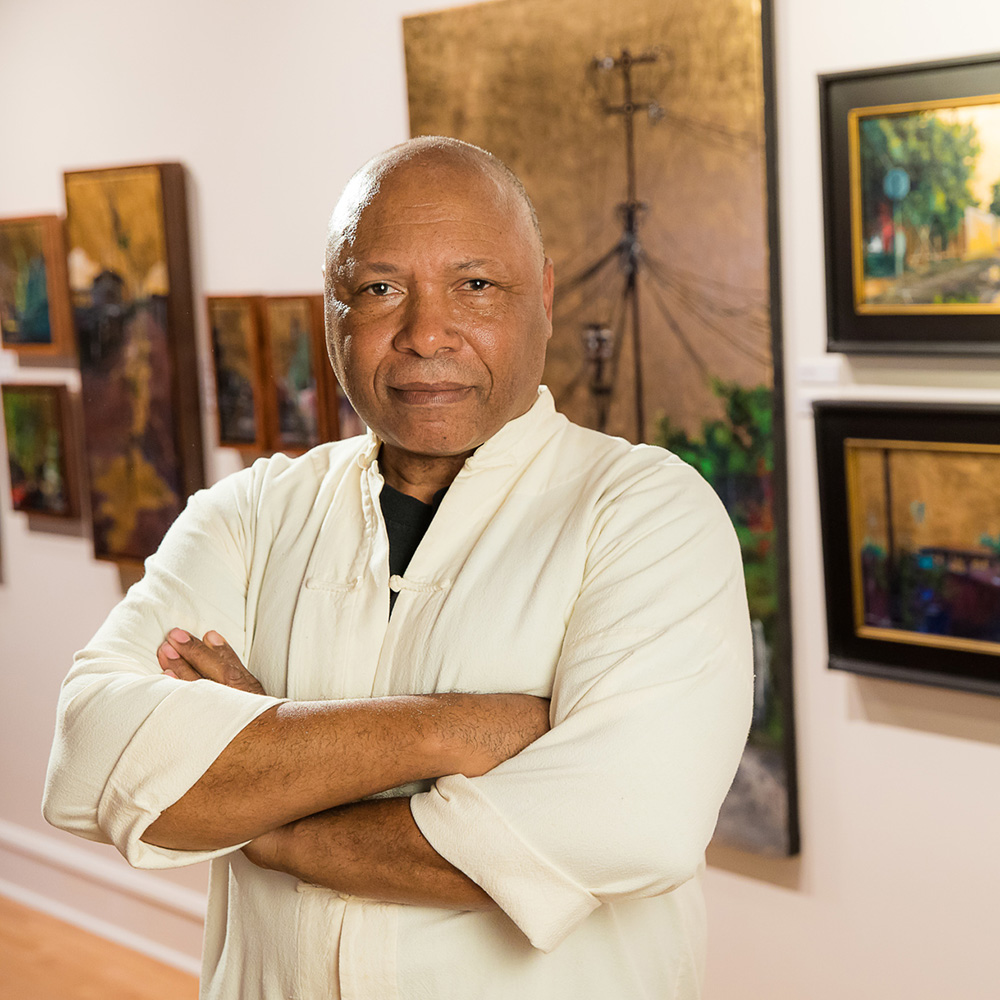Q&A With Duke Windsor

In our recent interview with represented artist Duke Windsor, the artist shares his extensive historical and contemporary inspirations that have driven his creativity over the decades, and discusses some techniques and advice that have guided his practice.

Sparks: Reverence (your gold-gilded work in your current portfolio) is inspired by different historical art styles; you mentioned Russian Icons and the work of Gustav Klimt most recently. What other art movements or periods in time have inspired your work in past shows?
Windsor: Most of my inspiration came from what I admired. For my watercolor, it was Winslow Homer, JMW Turner, Thomas Eakins, and Andrew Wyeth. Western works were and are inspired by Charles Russell, Remington, and Sam Harris. My wildlife is Carl Brenders and Guy Koleach.
The abstract works come from the inspirations of many of the Abstract Expressionist movement and the results of Rothko, Klein, and Frankenthaler, as well as Pierre Solange, Diebenkorn, and the slashed canvases of Fontana.
As a child, I knew I was interested in art after looking through my mother’s family bible. In that huge book (The King James Version), large color plates of painted scenes were taken from the Scriptures. Later I learned that many were commissioned by the Catholic Church for great masters, such as Caravaggio, Rembrandt, Delacroix, and Van Dyke, to name a few. I used to try and copy them all of the time.
Some fine art purists may be appalled by this: the first inspiration of painters for me was seeing the works on the cover of the Saturday Evening Post illustrated by master genre painters Norman Rockwell and NC Wyeth.

Sparks: What changes in style have you noticed in your own work through the years and between the different shows you’ve had?
Windsor: I have seen shifts in my approach to color, which is less formulaic and more intuitive now and is decided at the moment and not contrived. Of course, the addition of gold leaf is used more to set the mood and tie everything together. If the gilding is off, then it all will fall apart.
Sparks: Do you believe people need to understand the historical inspiration/context behind a work to fully appreciate it?
Windsor: Yes. I do. Therefore, when I teach any course, I give a small lecture on history to provide historical context to the class. The same goes for the collection of a piece of art. There should be more for the collector to know about the work they chose to purchase. They should know and understand the artist as well.

Sparks: Do you have a technique or a ritual for getting into a creative state of mind for painting? Do you listen to music, have tea or coffee on hand, do exercises, etc?
Windsor: If I’m working on a new series, I enter the studio with a goal in mind. Coffee is ready. KPBS is playing during most of my sessions. If it’s abstract, I listen to jazz, preferably Ella, John Coltrane, Bessie Smith, or Miles Davis. If I’m in a crappy mood, it’s METALLICA or AC/DC!!!
Sparks: What living, contemporary artists inspire you?
Windsor: For watercolor, I really love the work of Dean Mitchell. In regards to Contemporary Western I look to the master painters Tom Gilleon and Mark Magoon.
Sparks: What new concepts are you looking forward to exploring next in your art practice?
Windsor: I look to expand my use of more palette knife impasto applications, other media, collage, and possibly incorporating text. I want to return to sculpture again and explore the more expressive voice in assemblages, similar to how Lousie Nevelson was able to explore. I admired her pieces’ monochromatic nature, almost like abstract altarpieces.

Sparks: How has working in the museum sector affected your outlook on the art world or industry? What advice do you have for young artists or creatives?
Windsor: Working in the museum field for over 15 years helped me understand many aspects of the area. From my beginnings as a professional exhibition preparator, working as an assistant to the registrar, running a carpenter shop, designing a full museum exhibition, and finally managing a whole department have given me all the tools needed to be a well-rounded fine artist. I learned many aspects of the art business.
You should seek a mentor you trust in navigating the real art world. Live close to an art center you want to be a part of. Go to art shows to meet artists and museum shows to meet curators. Focus on your art career and live comfortably to survive and thrive. Watch out for too much debt.
Being in the studio and painting is only part of the art world I’d never stop learning. Even today, at 62, I’m working towards an MBA. My advice is to seek out knowledge. Even if you have your BA or even MFA, learning never stops.
Have fun creating.

